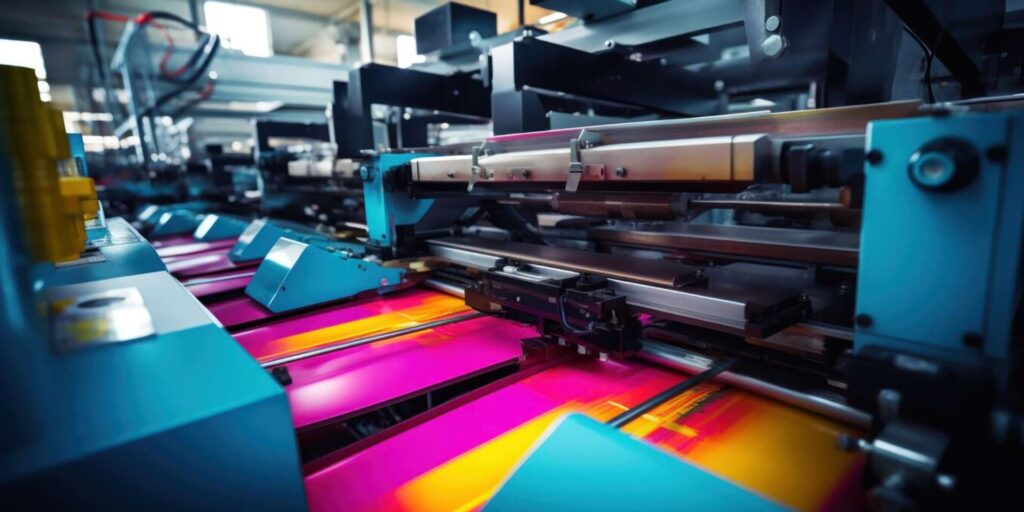The pandemic of COVID-19 opened many eyes to the reality that life can be quite uncertain and unpredictable—particularly regarding job security. For most professionals, it was the last straw in taking charge of their careers and chasing the dream of working for themselves, all from the comfort of their own homes.
If you have dreamed of being in control of your destiny, working at something you enjoy daily, and making a positive contribution, today could be the day to begin.
And the chances are with you! Yes, it’s a fact that seven out of ten home businesses make it big, and some of the most renowned companies in the world—Apple and Amazon—have started life as small home-based ventures. The same stimulating possibilities apply to print businesses owing to the development of web-to-print technology and the need for networked printed material.
The global printing industry is thriving despite living in an increasingly digital world. The U.S. printing sector alone is projected to reach a massive $90.3 billion, while the worldwide market is expected to hit $960 billion. This steady growth is fueled by the demand for digital and commercial printing services, especially as businesses prioritize high-productivity solutions and eco-friendly practices.
Beginning your small print business can appear overwhelming at first glance, but with advice, planning, and strategy — your business dream can become a reality.
This comprehensive guide will take you step-by-step from choosing your niche to building resources, becoming compliant, and launching successful marketing campaigns. So, are you prepared to join the world of self-employment? Let’s go into How to Start a Small Printing Business in 2025!
Why Should You Start a Printing Business?
If you’ve ever fantasized about working for yourself, living your dream, and creating something that makes a difference from scratch, launching a print business in 2025 can be your smartest move. The appeal isn’t just artistic freedom alone, but also the unthreatened expansion of the worldwide printing industry.
Freedom & Control
As the owner of a printing business, you can dictate your ideas, products, and expansion to your heart’s desire. You can try new product lines, change strategies, and adapt as the market adapts — however you prefer. Whether you start a small printing business or aim for large-scale operationsCommercial prints, packaging, or specialty merchandise might be your specialty, but there are no limits, and you’re in charge.
Ownership & Value
With your own business, you own 100% of your ideas, concepts, and customer relationships. You also own your earnings and brand. Additionally, you determine how much you can pay for the value you create, and there are fair returns on your creativity and work.
Evergreen Demand
Despite digital alternatives, the written word remains at the core of businesses worldwide. From flyers and business cards to banners and promotional materials, print plays a critical role in marketing, branding, and everyday business activities.
Industry Growth & Market Potential
The global printing industry is projected to reach $960 billion by 2025, growing at 2.5% annually.
In the US alone, the market size will be more than $80 billion, with digital printing adding more than $25 billion in sales. For entrepreneurs looking to start a small printing business, this is a great time to enter a growing market with high demand.
Packaging printing — driven by the trend of sustainability and e-commerce — will account for 30% of total sales and record 4% per annum growth. This wave of growth is also generating employment, with the sector workforce expected to increase by 12% since companies require digital, 3D, and AI-driven printing capabilities.
Multiple Revenue Streams
A print business is more than one product or service. You can branch out into:
- Commercial and packaging printing
- Custom merchandise and promotional items
- Specialty products for niche markets
This adaptability allows you to grow and develop with shifting consumer trends, making your business future-proofed and sustainable.
Potential for Scalability
Going small isn’t the same as staying small. With more sophisticated digital print technologies, it is now easier than ever to start a small printing business with basic equipment. get your business underway with basic equipment and grow your business along with your base of customers. Digital printing, on its own, is projected to have over 50% of the market space, the quickest-growing segment.
Lower Entry Barriers
New web-to-print and digital technology have also decreased start-up expenses, with affordable, easy-to-use hardware and software previously within reach of small businesses. This minimizes the risk of financial loss and eases entrepreneurship.
Creative Fulfillment
If you are a designer, the print industry allows you to direct your creative energy towards successful projects. Assisting clients in bringing their visions to life while being able to provide their stamp is both personally rewarding and professionally fulfilling.
Lorem ipsum dolor sit amet, consectetur adipiscing elit. Ut elit tellus, luctus nec ullamcorper mattis, pulvinar dapibus leo.
Technological Advancements & Sustainability
The printing business is also changing with technology and green awareness. AI-based printers are streamlining production and conserving wastage, and 3D printing, growing at a 23% CAGR, is transforming mass production of customized products. Those planning to start a small printing business can now explore modern solutions with Green-friendly printing solutions are the new norm in the business, giving businesspeople an edge through eco-friendly customers.
Types of Small Printing Businesses
Once you’ve decided to start a small printing business, the next step is identifying the niche that best matches your interests, skills, and market demand. The printing industry offers several specialized directions with opportunities and a customer base. Here’s a closer look at the most promising business models:
Digital Printing Shop
Digital printing best suits entrepreneurs who want to deliver quick, economical, and high-quality printing. It revolves around delivering advertising materials like brochures, flyers, business cards, and personalized products. Digital printing accommodates short-order runs, variable data printing, and on-order ordering with lesser setup costs compared to conventional printing—best for companies that demand flexibility and immediate turnaround.
Screen Printing Business
If you’re interested in apparel and promotional items, a screen print company can be the solution. This business is excellent at imprinting on cloth and providing customized t-shirts, uniforms, tote bags, and specialty items. Screen printing is famous for making bold and long-lasting imprints, so it’s an excellent option for customers requiring quality and durability in their promotional items.
Wide-Format Printing
Wide-format printing is the best solution for companies that desire to produce bulk marketing materials. If you’re planning to start a small printing business, The process includes printing banners, posters, trade show exhibits, car wraps, and business signs. It is suitable for companies that desire to announce something and require high-visibility advertising materials. It is an excellent niche for people who want to create branded products for companies, events, and corporate gifts.
Print-on-Demand Services
If retaining a low initial investment and inventory is essential, then a print-on-demand enterprise makes sense. To streamline your product presentation and marketing, consider using a bulk mockup generator to create professional mockups and product images at scale, saving time and enhancing your online listings.
Eco-Friendly Printing
Green printing has become a pioneering niche, with more businesses and consumers shifting towards sustainability. It is all about paper recycling, using biodegradable inks, and minimizing energy use with eco-friendly printing technology. Not only do green practices fulfill increasing customer demands, but they also make your company a sustainable and innovative brand.
Checklist Before Starting A Business
Before proceeding with the steps to start a small printing business, ensure you check boxes for all these points:
- Market Research: Identify local and internet-based competition, evaluate customer demand for specialty printing services, and determine whether your market region can support growth.
- Financial Planning: Project the initial costs, including equipment, materials, leasing space, licenses, and insurance, and project and account for expenses. Create logical financial projections and a break-even analysis to maintain long-term profitability.
- Skills Assessment: Assess your printing capability, design software skills, and business management background. Determine training deficiencies or employ trained personnel to close gaps.
- Business Structure Choice: Depending on tax savings, liability safeguards, and organizational ease, select the optimum business structure—sole proprietorship, partnership, LLC, or corporation.
- Support Network: Connect with counselors, industry associations, vendors, and business advisors. Attend trade shows and networking functions to grow professional networks.
Concentrating on these areas will create a strong platform for a prosperous printing business.
Step-by-Step Guide to Start a Small Printing Business
It is a profitable business opportunity for businessmen with creativity, accuracy, and a keen eye for detail to set up a small print shop. Success in this competitive industry depends on careful planning, market sensitivity, and a clear master plan. This is a step-by-step guide to help you start a small printing business confidently.
1. Choose a Niche

No business will succeed without specialization, and Starting a Small Printing Business begins by defining your niche. Rather than serving everyone, specialize in one area.
- Market Gaps: Observe what is lacking in your immediate area. For instance, green packaging and personalized business materials are fashionable themes to be exploited.
- Test Your Passions: Your interests will likely dictate resilience and imagination. Fashion students can specialize in clothing printing, and art students can focus on fine art copying.
- Assess Profitability: Balance your passion with profitability. High-value products like architectural plans can overwhelm simple flyer printing in terms of income.
- Long-Term Trends: Focus on enduring demands like business stationery and personalized gifts rather than short-term trends.
- Analyze Competition: Conduct market research to establish gaps or saturation.
Providing creative solutions can make your business stand out.
2. Decide What to Sell
Developing a smart product mix is essential when you start a small printing business. Customers want staples as well as customized solutions.
- Business Basics: Letterhead, envelopes, business cards, and presentation folders are always necessary.
- Marketing Items: Flyers, brochures, catalogs, and direct mail pieces give companies effective marketing materials.
- Signs & Displays: Trade show booth materials, posters, and banners help companies attain more visibility.
- Personalized Items: Greeting cards, calendars, and photo books are perfect for business and individual clients.
- Specialty Products: Vinyl wraps, stickers, customized mugs, and promotional pens add value and diversity to your products.
Being clear on what to sell helps you in establishing your business more productively.
3. Determine Where to Sell

Select the appropriate mix of sales channels to successfully start a small printing business.
- Physical Storefront: A storefront allows local customers to view samples and establish trust.
- E-commerce Website: An online store provides worldwide access and 24/7 convenience.
- Marketplaces & Platforms: Etsy, Amazon, and Printify expose your customer base immediately.
- B2B Direct Sales: Establishing long-term business relationships can lead to repeat bulk orders.
- Wholesale Partnerships: Collaborate with creative agencies and event planners to expand your audience.
- Pop-Up Shops & Events: Participate in fairs and expos to reveal your skills and engage with leads.
A combination of offline and online strategies boosts your exposure and improves toughness.
4. Business Plan Development

Any great adventure starts with a map, and commencing a small printing venture will need an impeccably laid business plan.
- Executive Summary: Summarize your vision, target market, and unique selling proposition briefly.
- Business Description: Announce your legal structure, services, and aims.
- Market Analysis: Mention industry trends, customer segments, and competition.
- Product & Service Line: Enumerate your products/services and their value proposition in the market.
- Marketing & Sales Strategy: Map campaign, promotion, and customer acquisition strategies.
- Operations Plan: Outline your equipment, process flow, suppliers, and quality controls.
- Management Team: Present your leadership and their applicable expertise.
- Supporting Documents: Include supplier quotes, designs, and research results.
A good plan provides direction for your business and makes it simpler to fund.
5. Equipment and Supplies Needed

The foundation of any effort to start a small printing business is adequate equipment.
- Printing Machinery: Select equipment suitable for your specialty, from computer printers to heat presses.
- Finishing Machinery: Binding machines, laminators, and paper cutters maintain professional outputs.
- Computer and Software: Spend time on Adobe Creative Suite, RIP software, CRM software, and accounting software.
- Supplies: Stock several types of paper, ink, toner, binding materials, and shipping materials.
- Production Area: Outfit your office with ergonomic chairs, shelving units, and proper lighting for efficient functions.
Good-quality equipment will ensure smooth production and therefore help overall business growth.
6. Legal and Regulatory Requirements

Ensure you meet all legal specifications before fully starting a small printing business.
- Business Registration: Select your form of business — sole proprietor, LLC, or corporation.
- Permits and Licenses: Procure tax ID numbers and licenses for your region.
- Intellectual Property: Adopt established policies for safeguarding clients and original content.
- Tax Compliance: Adhere to state and federal regulations, such as income, employment, and sales tax.
Legibility in the law gives you trust and protects you from costly mistakes.
7. Organizing Your Workspace
A well-planned space is critical to effectively launching a small printing business.
- Location: Choose a convenient location but within budget.
- Environmental Controls: Regulate temperature and humidity for material storage.
- Electrical Setup: Provide sufficient power supply for high-performance equipment.
- Lighting and Safety: Provide color-accurate lighting and provide fire safety gear.
- Ergonomics: Create comfortable, efficient workspaces.
- Security: Secure assets with alarms, locks, and surveillance systems.
A good workspace will reflect directly on your output quality and team performance.
8. Marketing and Sales Strategies

Without a solid marketing plan, it is not possible to start a small printing business.
- Brand Development: Establish a strong brand image with logos, colors, and messages.
- Website Optimization: Keep it user-friendly, mobile-friendly, and portfolio-heavy.
- Content Marketing: Post educational content to develop authority.
- Portfolio Building: Showcase high-quality work to acquire premium clients.
- Networking: Participate in industry conferences and local business organizations.
- Social Media Presence: Engage actively in posting client jobs and printing tips.
- Local Promotions: Offer discounts, sponsor local events, and reward repeat business.
- Email Campaigns: Engage clients with news and offers.
Good marketing creates long-term growth, which paves a long way for success.
9. Pricing and Profitability

When you start a small printing business, your prices must be value-based and result in profit.
- Market Research: Monitor competition but attempt to add value, not reduce costs.
- Value-Based Pricing: Price according to benefits for customers, not costs.
- Profit Margins: Establish target margins for various levels of products.
- Price Reviews: Periodically review your prices according to market conditions and costs.
- Customer Education: Inform customers what drives prices to move attention away from cost and towards quality.
Smart pricing earns trust and stabilizes your company financially.
10. Customer Service and Operations

Last but not least, starting a small printing business requires excellent service in order to succeed in the long term.
- Order Management: Track job progress using software.
- Clear Communication: Establish proofing, approval, and delivery expectations.
- Quality Control: Check every job for alignment, trimming, and color match.
- Proofing Process: Offer samples for client sign-off.
- Customer Database: Save repeat order options.
- Inventory Management: Automate inventory monitoring to prevent stockouts.
- Continuous Improvement: Request feedback, find workflow gaps, and grow.
Prioritizing quality and efficiency will give your printing company a good reputation and sustainable growth.
SEO Tactics to Expand Your Small Printing Company
Excellent equipment and design capabilities are not sufficient to start a small printing business—it needs to be seen in a crowded online environment. Integrating intelligent and proven SEO practices for print businesses can make your website a lead-generation platform and offer long-term growth for your business.
Local SEO Optimization
Your initial step towards visibility is Local SEO. Claim and own your Google Business Profile with proper NAP (Name, Address, Phone Number) information listing. Add rich-quality photos of work — brochures to business cards — and have a consistent posting with frequent updates on special offers, services, and new products.
Keyword Research and Implementation
It is most crucial to be attuned to what your customers are seeking. Perform solid keyword research using tools such as Google Keyword Planner or Ubersuggest. Incorporate location-based keywords such as “rush business card printing near me” organically into your service pages, blogs, and meta descriptions. Your content is viewed precisely when potential clients search for your services, boosting your organic reach and engagement.
Content Creation Strategy
Content remains the foundation of all successful SEO strategies. Create informative blogs and step-by-step guides that answer typical printing issues, like choosing a paper stock or preparing files for professional printing.
Technical SEO Components
Your website should be quick to load, mobile-friendly, and HTTPS to ensure security. Google prefers sites that have a fluid user experience. Add structured data markup to help search engines understand your services, opening time, and address better. Technical SEO optimization will make search engines and users believe in your site, and there will be higher ranking and visibility.
Backlink Building
Collaborating with allied businesses is one of the best methods of constructing quality backlinks. Contact design companies, marketing strategists, and event coordinators to trade guest posts or participate in cross-promotions. These relationships not only provide high-authority backlinks but also diversify your local business environment so that your business name is heard about, used, and referred to more frequently.
How to Reach Your Target Audience
Targeting your desired customer segment is critical to succeed in the print industry. These are some tested ways to refine your marketing target when starting a small printing business:
Customer Persona Creation
Start by creating in-depth customer personas that acknowledge your audience’s needs, pain points, and expectations. Knowing their budget constraints and problems assists you in placing your services to address actual-world needs, giving your communication precision and strength.
Strategic Partnerships
Scaling is achieved through collaboration. Partner with companies with your target customer base, such as ad agencies or graphic designers. Happy partners refer clients to your business, exposing you to new audiences without pushy sales.
Industry-Specific Marketing
Specialization opens the door to specialty markets. From real estate pamphlets to event banners and restaurant menus to every other kind of design, create packages that solve industry-specific problems. Employ industry-specific keywords so that your solutions are discovered when your clients search with targeted terms.
Educational Workshops
Organizing free or paid workshops on print marketing techniques and design principles informs prospective customers and asserts your authority on the topic. These in-person interactions establish trust and convert long-term.
Targeted Digital Advertising
Run a targeted ad on Google, Facebook, and LinkedIn. Use geo-targeting and demographic filtering to get in touch with local businesspersons and entrepreneurs who are actively looking for printing services. Intelligent advertising makes your money spent on reaching the most relevant audiences.
Client Retention Program
Acquiring new customers is more expensive than holding onto existing ones. Create a formal client retention program with one-on-one follow-ups, reward discounts, and VIP previews of new products. Long-term relationships turn single transactions into brand champions.
Conclusion
In 2025, success in building a small print business will be determined by how you reconcile new digital technology with old-fashioned craftsmanship. How creatively you can solve customers’ problems will be the key to your position in the market.
Evolve with the latest trends, from green printing to customized promotional materials, without compromising quality service standards. Companies that adopt digital technology and personalized customer services will dominate the future printing business. Your dedication and the above strategies are the roadmap to start a small printing business that endures and flourishes.
Discover More Realted Blogs:
FAQs
What capital outlay is required to start a small print business?
The initial cost will depend on the level of service. For printing machines digitally, you’ll need $10,000 to $30,000. Large-scale commercial production costs more than $100,000. Be lean at the beginning and scale as revenue grows.
Can I profit from the printing business without experience in graphic design?
Yes. Graphic design capabilities are helpful, but always outsource through freelance designers or hire them as you expand. Understanding the basics of design will enhance client interaction and workflow optimization.
What is the most lucrative printing sector in 2025?
Sustainable packaging, personalized promotional items, and wide-format printing will take the lead. Your selection must align with local demand, competition, and firm strengths.
What technique enables me to compete with enormous online printing business providers?
Emphasize personal service, fast turnaround time, and vigorous local community appeal. Provide walk-in consultations, rush orders, and special prices to help your hometown compete against the big guys.
How relevant is social media to marketing a printing business?
Social media sites such as Facebook, LinkedIn, and Instagram are also vital for displaying your portfolio, offering promotions, and interacting with customers. Constantly uploading ensures brand expertise is developed and new leads are drawn in the long term.
